With the school summer holidays upon us we thought we would share some ideas to help entertain the kids, and you never know, maybe help inspire the next generation of chemists! See our selection of chemistry experiments for kids:
- Floating Eggs: An egg sinks to the bottom if you drop it into a glass of ordinary drinking water but what happens if you add salt? The results are very interesting and can teach you some fun facts about density. You’ll need: an egg, water, lots of salt, a tall drinking glass. What you need to do: Pour water into the glass until it is about half full. Stir in lots of salt (about 6 tablespoons). Carefully pour in plain water until the glass is nearly full (be careful to not disturb or mix the salty water with the plain water). Gently lower the egg into the water and watch what happens. Salt water is denser than ordinary tap water, the denser the liquid the easier it is for an object to float in it.
What happens: When you lower the egg into the liquid it drops through the normal tap water until it reaches the salty water, at this point the water is dense enough for the egg to float. If you were careful when you added the tap water to the salt water, they will not have mixed, enabling the egg to amazingly float in the middle of the glass.
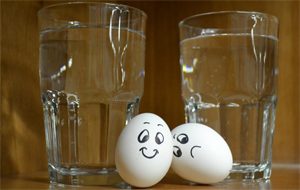
- Make your own quick sand: Quick sand is a strange substance! Make some of your own and experiment on a safe scale. The group of scientists in cult TV show, “The Big Bang Theory” did this and bounced it around in a speaker (which was protected by a layer of cling film) with great effect! You’ll need: 1 cup of cornflour, half a cup of water, a large plastic container, a spoon.
What you need to do: This one is simple, just mix the cornflour and water thoroughly in the container to make your own instant quick sand.
When showing other people how it works, stir slowly and drip the quick sand to show it is a liquid. Stirring it quickly will make it hard and allow you to punch or poke it quickly (this works better if you do it fast rather than hard). Remember that quick sand is messy, try to play with it outside and don’t forget to stir just before you use it.
What happens: If you add just the right amount of water to cornflour it becomes very thick when you stir it quickly. This happens because the cornflour grains are mixed up and can’t slide over each other due to the lack of water between them. Stirring slowly allows more water between the cornflour grains, letting them slide over each other much easier.
Poking it quickly has the same effect, making the substance very hard. If you poke it slowly it doesn’t mix up the mixture in the same way, leaving it runny. It works in much the same way as real quick sand.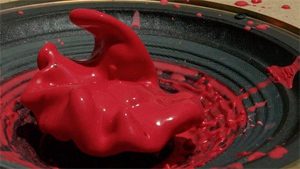
- Make your own mucus: Snot actually serves an important purpose in our body so this experiment is not all about grossing out our friends, although that’s certainly part of the fun. You’ll need: Boiling water (be careful with this), a cup, gelatin, corn syrup, a teaspoon, a fork. What you need to do: Fill half a cup with boiling water. Add three teaspoons of gelatin to the boiling water. Let it soften before stirring with a fork. Add a quarter of a cup of corn syrup. Stir the mixture again with your fork and look at the long strands of gunk that have formed. As the mixture cools slowly add more water, small amounts at a time. I’d add some colouring to the water myself to get a more fun mucus!
What happens: Mucus is made mostly of sugars and protein. Although different than the ones found in the real thing, this is exactly what you used to make your fake snot. The long, fine strings you could see inside your fake snot when you moved it around are protein strands. These protein strands make snot sticky and capable of stretching.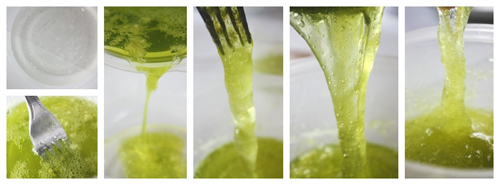
- Make a simple lava lamp: Use simple household items such as vegetable oil, food coloring, Alka-Seltzer and a bottle to create chemical reactions and funky balls of color that move around like a real lava lamp. You’ll need: water, a clear plastic bottle, vegetable oil, food coloring, Alka-Seltzer (or other tablets that fizz).
What you need to do: Pour water into the plastic bottle until it is around one quarter full (you might want to use a funnel when filling the bottle so you don’t spill anything). Pour in vegetable oil until the bottle is nearly full. Wait until the oil and water have separated. Add around a dozen drops of food coloring to the bottle (choose any color you like). Watch as the food coloring falls through the oil and mixes with the water. Cut an Alka-Seltzer tablet into smaller pieces (around 5 or 6) and drop one of them into the bottle.
What happens: Things should start getting a little crazy, just like a real lava lamp! When the bubbling stops, add another piece of Alka-Seltzer and enjoy the show! The oil and water you added to the bottle separate from each other, with oil on top because it has a lower density than water. The food coloring falls through the oil and mixes with the water at the bottom. The piece of Alka-Seltzer tablet you drop in after releases small bubbles of carbon dioxide gas that rise to the top and take some of the colored water along for the ride. The gas escapes when it reaches the top and the colored water falls back down. The reason Alka-Seltzer fizzes in such a way is because it contains citric acid and baking soda (sodium bicarbonate), the two react with water to form sodium citrate and carbon dioxide gas (those are the bubbles that carry the colored water to the top of the bottle).
Adding more Alka-Seltzer to the bottle keeps the reaction going so you can enjoy your funky lava lamp for longer. If you want to show someone later you can simply screw on a bottle cap and add more Alka-Seltzer when you need to. When you’ve finished all your Alka-Seltzer, you can take the experiment a step further by tightly screwing on a bottle cap and tipping the bottle back and forth, what happens then?
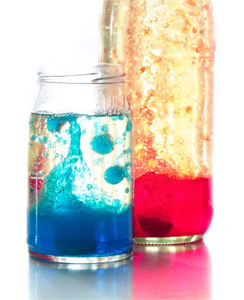
- Blowing up balloons with carbon dioxide: Chemical reactions make for some great experiments. Make use of the carbon dioxide given off by a baking soda and lemon juice reaction by funnelling the gas through a soft drink bottle and in to your awaiting balloon! You’ll need: a balloon, about 40 ml of water (a cup is about 250 ml so you don’t need much), soft drink bottle, drinking straw, juice from a lemon, 1 teaspoon of baking soda. What you need to do: Before you begin, make sure that you stretch out the balloon to make it as easy as possible to inflate. Pour the 40 ml of water into the soft drink bottle. Add the teaspoon of baking soda and stir it around with the straw until it has dissolved. Pour the lemon juice in and quickly put the stretched balloon over the mouth of the bottle.
What happens: If all goes well then your balloon should inflate! Adding the lemon juice to the baking soda creates a chemical reaction. The baking soda is a base, while the lemon juice is an acid, when the two combine they create carbon dioxide (CO2). The gas rises up and escapes through the soft drink bottle, it doesn’t however escape the balloon, pushing it outwards and blowing it up. If you don’t have any lemons then you can substitute the lemon juice for vinegar.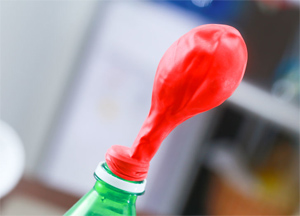 We’d love to hear how you get on! Tweet us your photos at @Asynt !
We’d love to hear how you get on! Tweet us your photos at @Asynt !




